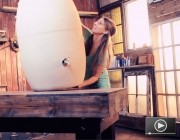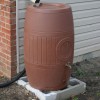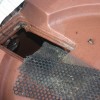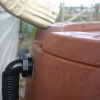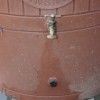Residential Rain Barrels
Video
Rainwater can be harvested with large, sophisticated, complex systems, linked rain barrels, or a single rain barrel. A single rain barrel is typically installed under a downspout as a repository for the rainwater collected by the roof gutters.
A properly designed system will reduce runoff, keep rainwater out of municipal sewers, and provide an adequate amount of soft water that can be used to water gardens, flowers, shrubs, and trees around your home.
Rain barrels are made from a variety of materials, including plastic, wood, metal, and clay. They can be built as a do-it-yourself project or fabricated by a manufacturer. Plastic rain barrels are one of the most common types of rain barrels used in residential applications. Made from a variety of virgin plastics and recycled plastic content, these rain barrels require little maintenance and are lightweight and low in cost. Wooden rain barrels are typically old whiskey barrels, which provide added charm with an aesthetically pleasing appearance, but they are heavy, more expensive, and require greater maintenance than plastic barrels. Metal and clay are uncommon types of materials for rain barrels but are available. Clay rain barrels are smaller and more decorative, while metal barrels have more of an industrial appearance. Available in a wide range of colors and styles, rain barrels range in size from 15 gallons to 1,000 gallons. The most common size is between 50 and 60 gallons. The choice of materials and requirements for assembly and installation results in a cost range from $10 to $250.
The common components of rain barrels include an intake, spigot, and overflow. The intake is the entry point for the rainwater and should be screened or filtered to prevent organic debris (leaves, trash, and dirt) from contaminating and clogging the stored rainwater. When the barrel reaches maximum capacity, the overflow provides an outlet for the excess rainwater. The spigot, which is typically located near the bottom of the barrel, is the main outlet for transferring the stored water for irrigation. Single rain barrels generally do not have a pressure pump and function as a gravity-feed system. This results in low pressure at the end of a connected hose and is typically inadequate for use with a lawn sprinkler or similar device. Barrels can be elevated to increase water pressure.
To determine the proper size for an installation, you should consider the average yearly rainfall for your area, the square footage of your roof, and the amount of water you intend to collect. Have an understanding of the scale of the rain barrel relative to your property and surrounding area. Rainfall varies across North America. Some regions receive less than 15" per year, while other regions get more than 80" per year. A 1,000 sq. ft. roof that receives 1" of rainfall will collect approximately 600 gallons of water. Roof area can be calculated by multiplying length times width and applying the proper multiplier for the roof's pitch, as shown below.
ROOF PITCH MULTIPLIER |
|
| PITCH | MULTIPLY BY |
| 4/12 | 1.06 |
| 5/12 |
1.08 |
| 6/12 |
1.12 |
| 7/12 |
1.16 |
| 8/12 |
1.20 |
| 9/12 |
1.25 |
| 10/12 |
1.30 |
| 11/12 |
1.36 |
| 12/12 |
1.42 |
Two main storage concerns when considering rain barrels are freezing temperatures and mosquitoes. Mosquito breeding is a concern anywhere that water collects. A quality rain barrel will have screened openings at the intake and overflow to prevent the entry of mosquitoes into a barrel. Alternative methods for eliminating mosquito breeding include goldfish or mosquito dunks. Freezing temperatures in northern climates during the winter months can also damage a rain barrel, depending on its type of material. Thin plastic and wooden rain barrels should be emptied and stored indoors, while thicker plastic rain barrels can be drained below the spigot and left outside. It is important to verify with the manufacturer's warranty the proper maintenance that should be taken to weather freezing temperatures.
A rain barrel is a sustainable system that conserves water by collecting and storing rain for future use, typically for landscaping irrigation, in lieu of municipal or other treated potable water. Using rain barrels can help you to save money on your water bills; overall, they reduce the demand for municipal water and thus decrease water supply and sewage costs.

Jeff Calcamuggio
Jeff is an Editor-at-Large for Buildipedia.com who writes and edits Featured At Home and Knowledgebase content. Prior to joining Buildipedia, Jeff's work experience included carpentry, construction documentation, specification writing, construction administration, project management, and real estate property inspection. Jeff is a member of the Construction Specifications Institute (CSI) and an educator at Columbus State Community College and enjoys challenging DIY home improvement projects.
†

